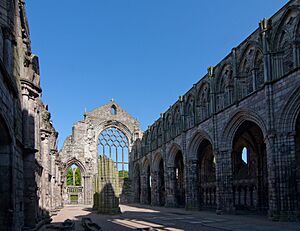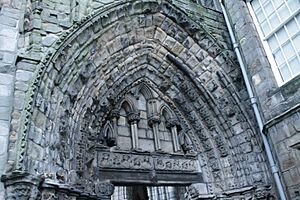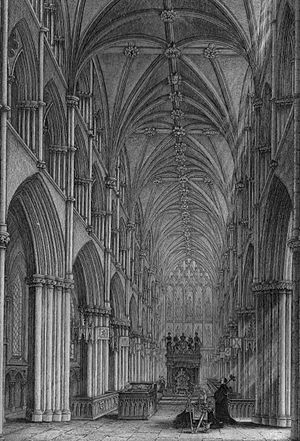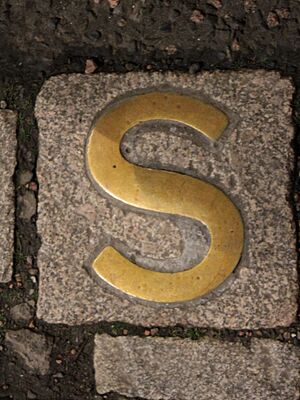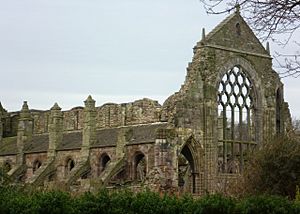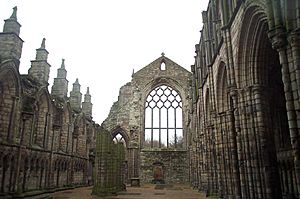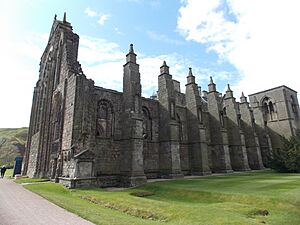Holyrood Abbey facts for kids
Holyrood Abbey is a very old ruined abbey in Edinburgh, Scotland. An abbey is a special type of monastery where monks or nuns live and worship. This abbey was started in 1128 by King David I. Over time, a royal palace, the Palace of Holyroodhouse, grew up next to it. The abbey church was used by local people for a while, but it has been a ruin since the 1700s. Today, you can see its remaining walls right next to the palace, at the end of Edinburgh's famous Royal Mile. This historic site is protected as a special monument.
Contents
What Does Holyrood Mean?
The word "Rood" means the cross that Jesus Christ was crucified on. So, "Holyrood" means "Holy Cross." It's a name that connects the abbey to a very important religious symbol.
A Look at Holyrood Abbey's History
How the Abbey Began
There's a famous story about how Holyrood Abbey started. In 1127, King David I was hunting near Edinburgh. A large deer, called a hart, startled his horse, and the king fell off. The story says that the king was saved from the charging deer by a miracle. Either a holy cross appeared from the sky, or sunlight reflected from a crucifix between the deer's antlers. To thank God for saving him, King David I built Holyrood Abbey on that very spot in 1128.
The church also held a very special item: a piece of what was believed to be the True Cross. This relic, called the Black Rood of Scotland, was brought by King David's mother, St. Margaret. Sadly, it was lost during a battle in 1346 and later disappeared during the Reformation.
Early Days and Changes
The abbey was first run by a group of monks called Augustinian Canons. The original church was mostly rebuilt between 1195 and 1230. The new building had a long main hall called a nave, and two towers at the front. The stonework wasn't always perfect, but the building was still very grand.
Many important people helped Holyrood Abbey over its 400 years as a religious place. These included Kings David I and II, and other powerful figures.
Around the abbey, there was a special five-mile area called a "sanctuary." This was a safe place where people who owed money or were accused of certain crimes could go for protection. They were sometimes called 'Abbey Lairds' and lived in buildings near the abbey. You can still see brass markers on the Royal Mile that show where this sanctuary began.
A Royal Meeting Place
Holyrood Abbey was often used by Scottish kings because it was close to Edinburgh Castle. The Scottish Parliament met there many times, starting in 1256. In 1326, Robert the Bruce held Parliament at the abbey. The Treaty of Edinburgh–Northampton, which ended a big war, was signed there in 1328.
By the mid-1400s, Edinburgh became the main city for the royal court. Kings started using the abbey's guest house more and more for royal events. King James II and his twin brother were born there in 1430. James II was also crowned at Holyrood in 1437 and got married there in 1449.
Between 1498 and 1501, King James IV built a royal palace right next to the abbey. The abbey's dining hall was even turned into a grand hall for the palace!
Challenges and Collapse
In the 1540s, during a conflict called the "Rough Wooing," English armies attacked Holyrood Abbey. They damaged the building, took lead from the roof, and stole its treasures. Then, in 1559, during the Scottish Reformation, a crowd destroyed the altars and looted the church even more.
After this, the eastern part of the abbey church was no longer needed for religious services. It was in such bad shape that it was pulled down. Only the nave, the main part of the church, was kept. This part then became the local church for the nearby town of Canongate.
In 1633, the abbey was changed a lot for the coronation of King Charles I. Later, in 1686, King James VII made the abbey a Roman Catholic Chapel Royal. However, in 1688, during the "Glorious Revolution," a mob broke into the abbey and damaged the royal tombs.
After these events, the abbey was not as important to the public. In the mid-1700s, people tried to replace the old wooden roof with a new stone one. This was a big mistake! The stone roof was too heavy for the old walls, which were already weak. The walls couldn't hold the weight, and the roof started to crack. For safety, the church had to be closed in 1766.
On December 2, 1768, the heavy stone roof finally collapsed. This is why Holyrood Abbey looks like a roofless ruin today.
People have suggested restoring the abbey many times since the 1700s, but none of these plans ever happened.
In 1829, the famous composer Felix Mendelssohn visited the ruins of Holyrood Abbey. He was so inspired by the place that it helped him create his famous Scottish Symphony.
Royal Connections at Holyrood Abbey
Holyrood Abbey was a very important place for the Scottish royal family.
Royal Coronations
Several Scottish monarchs were crowned at Holyrood Abbey:
- King James II in 1437
- Margaret Tudor (wife of James IV) in 1503
- Mary of Guise (wife of James V) in 1540
- Anne of Denmark (wife of James VI) in 1590
- King Charles I in 1633
Royal Weddings
Many royal weddings took place here:
- King James II and Mary of Guelders in 1449
- King James III and Margaret of Denmark in 1469
- King James IV and Margaret Tudor in 1503
Royal Births
- King James II was born at Holyrood in 1430.
Royal Burials
Many royals were buried at Holyrood Abbey, mostly in a special area called the "Royal Vault."
- King David II in 1371
- King James II in 1460
- Madeleine of Valois (wife of James V) in 1537
- King James V in 1542
- Henry Stuart, Lord Darnley (husband of Mary, Queen of Scots) in 1567
- Mary of Guelders (wife of James II) in 1463
Holyrood Abbey in Art and Literature
The ruins of Holyrood Abbey have inspired artists and writers.
- The French artist Louis Daguerre painted The Ruins of Holyrood Chapel in the 1800s.
- The poet Letitia Elizabeth Landon wrote a poem called 'Holyrood' after seeing a display of the abbey ruins in London in 1825.
See also
 In Spanish: Abadía de Holyrood para niños
In Spanish: Abadía de Holyrood para niños
- Abbeys and priories in Scotland
- Kirk of the Canongate
- Oldest buildings in the United Kingdom


